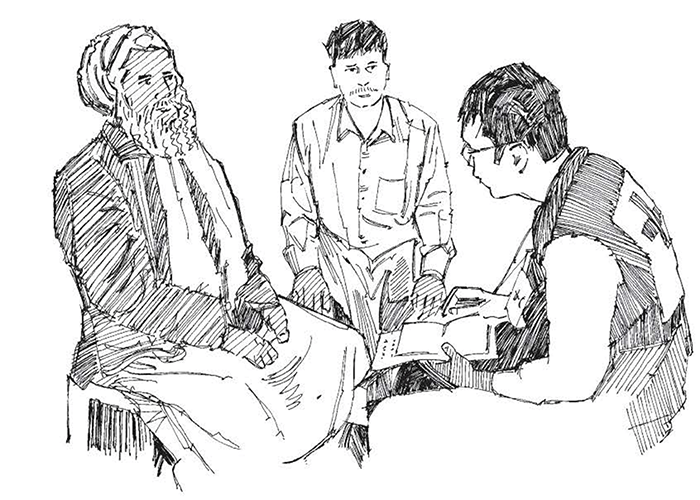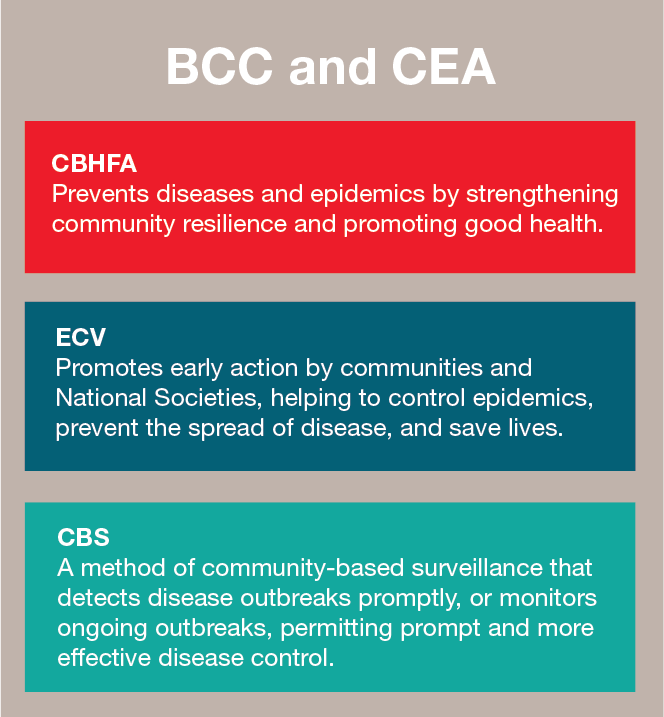Session 1.2. Volunteers and epidemic control
By the end of this session, you will be able to:
- Understand why volunteers play an essential role in epidemic control.
- Explain the importance of community volunteers and how they can be most helpful.
- Describe the role of volunteers in epidemics.
- Explain how volunteers should protect themselves in epidemics.
Part 1.2.1. Why do we need volunteers?
Why do we say that volunteers make a crucial contribution to efforts to control epidemics and help affected people and communities? Why do health professionals, doctors and nurses need their assistance? First of all, there are often too few health professionals. In addition, they are frequenly overstretched, or lack the resources they need to deal with all the people who are sick in their communities. This is especially true in epidemics where the number of people in need of care increases rapidly. Finally, health professionals work mostly in clinics and hospitals and are not always present in communities.
In such situations, Red Cross and Red Crescent volunteers provide essential forms of support. In many countries, they assist health professionals and governments to implement epidemic control measures. Their help is irreplaceable in the local communities in which they work or live.
Being a volunteer also has advantages for the volunteers themselves:
- They acquire knowledge, training and skills that will be useful in their lives.
- They derive fulfilment and satisfaction from helping others.
- Their value is recognized in their communities.
Group work
Divide into four groups. In each group, talk for a few minutes about what volunteers can do. Then each group should discuss one of the following cases:
- Benefits when a volunteer is from the community.
- Benefits when a volunteer has access to the community.
- Benefits when a volunteer has access to the health system.
- Benefits the volunteer obtains from his or her work.
Note the main points made by each group in the table below.
Being a volunteer from the community
Access to the community
Access to the health system
Personal benefit
What you have learnt above will help you to understand and appreciate your role as a volunteer in the management of epidemics.
Part 1.2.2. The importance of community volunteers
You are a Red Cross or Red Crescent volunteer. You live in a local community (in a village or a neighbourhood in a town or city). When you work as a volunteer to provide services or help manage an epidemic, you work in your community.
The advantages we talked about before apply to you because you come from the community in which you work. This means that you know the community, you have relationships with people in it, and you can communicate easily with them. The benefits that volunteers who come from the community bring include:
- You understand the community.
- You know the people and understand how they think.
- You know the community leaders.
- You can talk to people in their language.
- You know how to convince people to help themselves.
- You know the local habits and customs.
- You know local restrictions and opportunities.
- You are available most of the time, and you want to help others.
- You can meet everyone.
- Because members of your community trust you, they will be more willing to confide in you their concerns, fears, beliefs...
Can you think of some more advantages? Write them down below:
What do volunteers offer when epidemics occur?
You are a member of your local community, with all the advantages that we listed above. But, in addition, you have qualities that are important that others in your community may not have. You belong to a large organization (your Red Cross or Red Crescent National Society). You have been trained and are prepared to deal with epidemics. And you know what you should do in a crisis and how to do it.
When volunteers have these additional advantages, they are not only located in their communities but can be a vital link between their communities, the health system, and those who manage an epidemic.
Figure 1. Volunteers in epidemics

Part 1.2.3. The role of volunteers in epidemics
Volunteers can help in many different ways before, during and after an epidemic. In this manual, we discuss these. Can you list some of the actions you could take to help your community during an epidemic? Talk to your colleagues and the facilitator and write your ideas on the board.
After you have talked about your role as a Red Cross Red Crescent volunteer in the community and in relation to the health authorities, ask yourself how you can make use of your position to help prevent and control epidemics.
Responding to an epidemic is always complex. It involves a wide range of activities, from case detection to diagnosis, treatment and care, and from contact tracing to prevention and psychosocial support. The public health system’s capacity to cope may be overstretched by even small, limited epidemics, especially when it is weak or has been affected by floods, earthquakes, other natural disasters or conflict. The support provided by well-trained volunteers can therefore be critical.
However, each epidemic requires a coordinated response from the whole of society. National Society volunteers will be a part of a large team of public health officials, public health workers, healthcare professionals, community leaders, community service workers, etc. Volunteers will never work alone, though in some epidemic control activities their role can be dominant.
What can volunteers do to prevent, detect and respond to epidemics? This will depend on the cause of the epidemic, when, where and why it occurred, and the number of people affected by it. The role of volunteers will also be different at different stages of the epidemic response.
Module 3 describes various volunteer activities during the phases of epidemic prevention and preparedness, alert, response and recovery. Disease specific activities are listed in the disease tools. (See the Toolkit for more information about disease tools).
Activities common to all epidemics include:
- Prevention. If effective prevention measures are applied, an epidemic may not occur at all or will have less severe consequences.
- Preparedness. Before an epidemic, it is vital to foresee and assess the risk of a potential epidemic, prepare a plan, and gather resources.
- Early detection. When active community-based surveillance is in place, cases can be detected and reported promptly, giving public health officials and the society more time to prevent the disease from spreading and protect people from its effects.
- Early action. Once an epidemic is detected and declared, prompt action can slow its progress and make control measures more effective.
- Community engagement and risk communication. The three most important things volunteers do in epidemics are: to alert and mobilize communities; give them accurate information; and help them to adopt safer, less risky behaviour.
Your key role as a community volunteer is to support activities at community level.
Some epidemic response activities will mainly be under the responsibility of others:
- Health authorities declare outbreaks, provide overall coordination of an epidemic response, take legal measures (restrictions on movement, trade or traffic), lead communications, etc.
- Public health services are responsible for disease surveillance at health centres and clinics, epidemiological investigations, laboratory confirmation, etc.
- Healthcare professionals are in charge of clinical diagnosis, treatment of patients, and their care and support.
- Communal services monitor water supplies and ensure they are safe.
You will learn more about your expected role in future modules.
Part 1.2.4. Staying safe
In epidemics or health emergencies, you may be working in high-risk situations and with vulnerable people (see 1.3.4 for more information about vulnerabilities). Your behaviour should be culturally sensitive and you should never cause offence by your personal behaviour. Always act impartially and with integrity. Correct, polite and neutral behaviour by Red Cross Red Crescent staff and volunteers is always expected. Please inform a supervisor if you witness any incidents that raise concern in this respect.
When you work with communicable diseases, you may need personal protection equipment (PPE). The PPE you wear should be appropriate for the type of disease in question and its transmission paths, and the risk level of the task or duty you undertake.
In addition, you should be provided with protective equipment against common occupational hazards, for example hats or protection from the sun, raincoats or umbrellas, warm or insulated jackets, etc., as appropriate.
Table 1. Examples of minimum personal protective equipment (PPE) provided to volunteers for different disease groups.
| Diseases transmitted by mosquitoes | Respiratory infections | Highly contagious diseases |
|---|---|---|
|
PPE that prevents mosquito bites and protects from minor injuries. Includes:
|
PPE that helps to block transmission. Includes:
|
PPE that fully covers the skin and clothing and prevents exposure of the eyes, nose, and mouth. Includes:
|
Part 1.2.5. Training of volunteers
All National Society volunteers who will be engaged in epidemic control should receive the Epidemic Control for Volunteers (ECV) training. It will teach you about epidemics, diseases and their prevention and provide you with a range of skills that are useful when dealing with epidemics. The related trainings below will extend your knowledge:
- Community-based health and first aid in action (CBHFA). The first four modules are particularly useful: the Red Cross Red Crescent in action volunteer, Community mobilization, Assessment-based action in my community, and Behaviour change communication (BCC) for community-based volunteers.
- Community engagement and accountability (CEA)
- Community-based surveillance (CBS)
CBHFA modules provide information about the Red Cross Red Crescent and its principles and values, and your local National Society and its branches. You will learn what volunteering is, and about the values and responsibilities of volunteers. In addition, the module will teach you how to communicate and build relationships in a community and how to involve community members in Red Cross Red Crescent activities. Finally, you will explore the community to identify resources that might help the community to achieve its goals. These include tools to help volunteers to assess the community and its needs, map community resources and community vulnerabilities, and identify and prioritize health, first aid and safety issues.
The BCC module will teach you how to work with individuals, families and communities, promote positive behaviour that fits their circumstances, and provide a supportive environment that will enable people to act in a positive and appropriate manner.
The CEA module offers guidance and tools that help us to put the community at the centre of what we do and ensure that its views are heard. CEA tools enable us to communicate with people effectively and promptly and improve our accountability to the communities in which we work.
Community-based surveillance (CBS) explains health surveillance systems and how to plan and set up a CBS system at community level. CBS actively involves the community in detecting, reporting, responding to and monitoring local health issues. It detects unusual events, applies simple definitions to detect increases in the number of people falling sick, and sets up a communication link (via phone, SMS, paper, or even bicycle) to ensure that an appropriately qualified person is informed, who can investigate and confirm that an illness is occurring.
Diseases and epidemics are highly dynamic. New diseases sometimes emerge, and well-known diseases occur in unexpected ways. New prevention and control tools and new forms of treatment are always in development. This means that you will need to continue learning about epidemic control. You should actively attend refresher trainings and access new knowledge as it becomes available.
Figure 2. Red Cross Red Crescent key Community and Emergency Health approaches and tools linked to epidemic control

Underlying all three approaches (ECV, CBHFA and CBS) is Behaviour Change Communication (BCC) and Community engagement and accountability (CEA). Behaviour change communication with a strong community engagement (CEA) component promotes effective programming and better accountability by establishing trust and open communication and developing a sound understanding of local practices and perceptions.